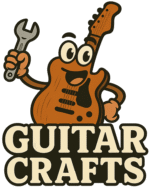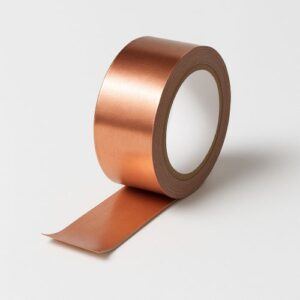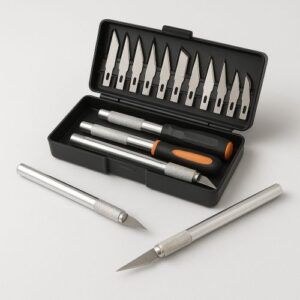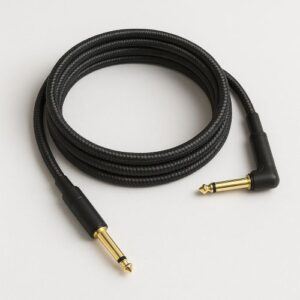If you’re building or modifying a kit guitar, understanding how to shield your guitar’s electronics for noise reduction is one of the most important upgrades you can make. Proper shielding can be the difference between a clean, professional sound and that annoying 60-cycle hum or buzzing that ruins your tone.
Shielding is one of the most overlooked but essential steps — especially with budget guitar kits or older guitars that were never shielded properly from the factory. The good news? You can do this upgrade yourself with just a few inexpensive materials.
In this guide, we’ll cover why shielding matters, what tools you’ll need, how to shield your control cavity and pickguard, and a few extra tricks to help you get a truly quiet, noise-free guitar.

Understanding Guitar Shielding: Why It Matters
What Is Guitar Shielding?
Guitar shielding refers to the process of lining the control cavities and pickup cavities with a conductive material—typically copper foil or conductive paint—to create a Faraday cage that blocks electromagnetic interference (EMI) and radio-frequency interference (RFI). These unwanted signals can creep into your guitar’s signal path and cause hum, buzz, and noisy interference, especially with single-coil pickups.
Does Guitar Shielding Really Reduce Noise?
In real-world situations, yes—especially in environments with high electrical noise or when using high-gain settings. While shielding won’t completely eliminate 60-cycle hum caused by single coils (for that, check out Understanding Humbucker Vs Single Coil Pickups In Kits), it significantly reduces interference from things like fluorescent lighting, dimmer switches, and even computer monitors.
The Science Behind Interference
Your guitar’s wiring acts like a collection of antennas. Without proper shielding, the internal wires and components can pick up stray electromagnetic signals, which get amplified along with your playing. Shielding creates a grounded barrier that diverts this interference away from your signal—resulting in a cleaner, quieter guitar.
Why Don’t All Guitars Come Properly Shielded?
Some manufacturers—especially budget kit makers—skip shielding to reduce costs. Others rely on the belief that good cables or pedals will manage most of the noise. But if you’re building your own guitar kit or customizing one, adding shielding is a low-cost upgrade that instantly improves sound quality.
Essential Tools and Materials for Guitar Shielding
Tools You’ll Need
-
Copper foil tape with conductive adhesive
-
Conductive shielding paint (graphite or carbon-based)
-
Small Phillips and flat-head screwdrivers
-
Soldering iron and solder
-
Digital multimeter (for continuity testing)
-
Masking tape and a razor blade or craft knife
-
Safety glasses and gloves
🌟 Amazon Product Suggestion:
✔️ Kirecoo Copper Tape
(2in × 33 FT) – Conductive Adhesive Shielding Tape
This high-quality Kirecoo copper foil tape is one of the most trusted options for shielding electric guitar cavities. With a fully conductive adhesive and a wide 2-inch roll, it applies smoothly, overlaps easily, and ensures strong electrical continuity — exactly what you want for reducing hum, buzz, and 60-cycle noise in guitar kits or custom builds.
Ideal for pickguards, control cavities, switch cavities, and grounding pathways.
Why it’s great:
✔ Fully conductive adhesive for complete electrical continuity
✔ 2-inch width covers cavities faster with fewer seams
✔ Strong adhesion sticks securely inside tight curves
✔ Easy peel backing for fast and clean installation
✔ Perfect for guitar shielding, pedal builds, and grounding repairs
✔ Affordable, top-rated, and beginner-friendly
Copper Tape vs. Conductive Paint
Copper tape is the most popular choice because it applies easily, sticks well, and provides excellent conductivity. It’s ideal for tight control cavities and precise work.
Conductive shielding paint, on the other hand, is perfect for uneven surfaces or large cavities. It’s faster to apply but usually requires multiple coats, and it’s typically not as conductive as high-quality copper tape.
If you’re unsure which material fits your build, check out Essential Tools Every Electric Guitar Kit Builder Should Have for a breakdown of recommended products and tools.
Choosing the Right Shielding Option
-
Copper Tape: Best for accuracy and DIY beginners
-
Conductive Paint: Best for curved or uneven surfaces
-
Combination: Many builders use tape on the pickguard and paint inside the cavity
DIY vs. Professional Services
DIY Shielding Pros:
-
Cost-effective
-
Fully customizable
-
Great hands-on learning experience
Cons:
-
Time-consuming
-
Requires careful disassembly
Professional Shielding Pros:
-
Flawless results
-
Faster turnaround
Cons:
-
More expensive
-
Less hands-on experience
If you’re comfortable with basic tools and a soldering iron, DIY shielding is absolutely doable — and extremely satisfying. If you’re brand new, check out the Step-by-Step Guide to Building Your First Electric Guitar Kit before you start.
Step-by-Step Guide: How to Shield Your Guitar’s Electronics
1. Prepare Your Workstation
Set up a clean, well-lit surface with a padded mat or towel to protect your guitar body. Have all your tools within reach and wear safety glasses if you’re using sharp tools or solder.
2. Disassemble the Guitar
Carefully remove the pickguard, pickups, knobs, and control plates. Take photos of wiring beforehand so you can reassemble everything correctly. Label parts as you remove them.
3. Apply the Shielding
Using Copper Tape:
- Cut strips and line the walls and floor of the cavity
- Overlap pieces slightly and press firmly to ensure adhesion
- Use a multimeter to confirm electrical continuity between pieces
- Extend the shielding to the pickguard or cover plate if applicable
Using Conductive Paint:
- Apply with a small brush in thin, even layers
- Allow 24 hours to dry between coats
- Apply at least two coats
- Test for conductivity between multiple points
🌟 Amazon Product Suggestion:
✔️ Conductive Shielding Paint
High-Conductivity Nanotech Formula
(1 fl oz)
This nanotechnology-based conductive paint is ideal for shielding curved, uneven, or hard-to-reach control cavities where copper tape is difficult to apply. It brushes on easily, dries quickly, and creates a continuous conductive barrier to help eliminate hum, interference, and 60-cycle noise.
With strong electrical conductivity and excellent coverage per ounce, it’s a go-to choice for builders who want a clean, sleek shielding layer without overlapping tape seams.
Why It’s Great:
✔ Brush-on convenience — no cutting or layering
✔ Nanotech conductive formula for strong EMI protection
✔ Perfect for uneven/curved surfaces (where tape fails)
✔ Dries quickly for faster project turnaround
✔ Great for guitars, pedals, synths, shielding boxes, and electronics
✔ Clean, seamless finish — no seams, wrinkles, or lifting edges
Ensure all shielding is connected and leads to a common ground. For more detail, visit Guide To Wiring Your Electric Guitar Kit For Optimal Performance.
🌟 Amazon Product Suggestion:
✔️ KAIWEETS 6000-Count Digital Multimeter
This KAIWEETS multimeter is one of the best budget-friendly meters for guitar electronics. With accurate auto-ranging, fast continuity response, and the ability to measure resistance down to fine increments, it’s perfect for checking whether your shielding makes proper electrical contact — and for diagnosing wiring issues inside your guitar kit.
It includes durable test leads, a bright backlit display, and reliable build quality that makes it ideal for beginners and experienced builders alike.
Why It’s Great:
✔ Continuity check — instantly verifies connections
✔ Resistance readings — confirms grounds & wiring health
✔ Auto-ranging — no guessing which setting to use
✔ Bright backlit screen — easy to read inside control cavities
✔ Safety-rated, sturdy design — great for workshop use
✔ Top-rated & affordable — excellent value for guitar builders
🌟 Amazon Product Suggestion:
✔️ YIHUA 926 III Digital Soldering Station
Precision Temp Control + Full Accessory Kit
(60W)
This upgraded YIHUA station delivers fast heating, stable temps, and way more control than the cheap “best-seller” soldering kits. It includes multiple tips, a solder sucker, tweezers, helping hands, and a smooth temperature dial — everything you need for clean shielding, wiring repairs, and pickup installs.
Why It’s Great:
✔ Digital temperature control — stable heat = cleaner, stronger solder joints
✔ 60W fast-heating element — reaches set temp quickly for efficient work
✔ Includes 6 precision tips — ideal for tight cavities and detailed guitar wiring
✔ Helping hands + stand — keeps parts steady while you solder
✔ Lead-free solder included — everything you need in one kit
✔ Auto sleep + safety features — runs cooler & safer in a home workshop
✔ Much higher quality than typical “best seller” soldering pens
🌟 Amazon Product Suggestion:
✔️ Jetmore 16-Piece Precision Craft Knife Set
Perfect for trimming copper tape, cutting shielding templates, and making clean cavity lines
This 16-piece Jetmore hobby knife kit gives you sharp, clean control for any detailed electric-guitar work. Whether you’re trimming copper foil inside a tight control cavity or shaping a clean edge around a pickguard shield, this set delivers the accuracy and stability cheap “best-seller” knives just can’t touch.
With 3 craft handles and 13 SK5 steel blades, you always have the right blade for the job — and the protective case keeps everything organized for fast swaps during wiring or shielding.
Why It’s Great:
✓ Ultra-sharp SK5 steel blades — perfect for cutting copper tape cleanly
✓ Multiple handles — better grip and better control inside tight guitar cavities
✓ Great for pickguards, templates, & shielding masks
✓ Precision cuts — reduces wrinkles, gaps, and lifting edges
✓ Compact case — keeps blades safe and organized in your toolkit
✓ Low cost, high value — ideal upgrade from budget knife sets
4. Test Your Shielding With a High-Quality Cable
Once your shielding is finished, reconnect your electronics, close everything up, and plug into your amp. Listen for a noticeable drop in hum or buzz by comparing the guitar before and after shielding — or by testing against another unshielded guitar.
Always use a high-quality instrument cable during testing. Cheap cables can create their own noise, making your shielding job sound worse than it actually is.
🌟 Amazon Product Suggestion:
✔️ Ernie Ball Braided Instrument Cable
(18ft – Straight/Angle)
This Ernie Ball cable gives you a clean, quiet signal that actually shows off your shielding work. The braided jacket keeps it tangle-free and durable, and the straight/angle plug setup is perfect for most electric guitar jacks.
Why It’s Great:
✔ Noise-free dual shielding
✔ Ultra-durable braided jacket
✔ Straight + right-angle connectors
✔ Gold-plated plugs for better contact
✔ Smooth, reliable signal for any guitar
Optimizing Your Electric Guitar for Minimal Noise
Maintenance Tips
- Keep your control cavity clean and dry
- Inspect solder joints and shielding tape periodically
- Use contact cleaner on pots and jacks
- Secure any loose wires
Proper maintenance ensures your shielding continues working at peak performance instead of degrading over time.
Use Your Pedals & Amp Settings to Reduce Noise
Shielding handles noise at the source, but pedals and amps still play a huge role in your final sound.
Noise suppression pedals help, but they’re only a band-aid — not a replacement for proper shielding. Also, setting your amp’s gain and EQ wisely can minimize background noise.
Grounding: The Silent Hero
Proper grounding of your guitar’s electronics is essential. A shielded cavity only works if it’s grounded to the rest of the circuit. Make sure the bridge and control cavity are part of your ground loop.
Identify Other Noise Sources
Don’t assume the guitar is always the problem.
Check these common noise sources:
✔ Bad power strips
✔ Low-quality amp cables
✔ Wi-Fi routers and fluorescent lights
✔ Daisy chaining too many pedals
The Pros and Cons of Shielding Guitar Wiring
Should You Shield the Wiring Too?
Some players go the extra mile by shielding the wiring between the pickups and the output jack. Twisted-pair wiring can also reduce interference. Full wiring shielding makes sense for guitars used in high-noise environments or on stage.
Cost vs. Benefit
-
Strat-style guitars benefit the most because of their larger, open cavities
-
Les Paul–style guitars often have some shielding already
-
Most DIY kits come completely unshielded, making this a worthwhile upgrade
For tone purists, there’s ongoing debate about whether shielding affects treble clarity — but most players don’t notice any difference, especially compared to the massive improvement in noise reduction.
Tone and Playability
Shielding doesn’t harm playability, and it can actually improve perceived tone clarity by removing background hiss. When combined with proper setup, shielding pushes your guitar closer to studio-quality performance.
Check out Adjusting Pickup Height for Optimal Sound on Your Guitar to dial in the rest of your tone.
What the Pros Say
Many pro luthiers consider shielding to be a must-do mod on both custom builds and kit guitars. It’s cheap, effective, and shows craftsmanship and attention to detail. Whether you’re a weekend builder or a gigging player, this is an upgrade that pays off every time you plug in.
Final Thoughts…
Learning how to shield your guitar’s electronics for noise reduction is one of the most cost-effective upgrades you can make. With a few simple tools and a bit of patience, you can eliminate annoying hum and enjoy a cleaner, more professional sound. Whether you’re building your first kit or your tenth, shielding is a small detail that makes a big difference.
For more build tips, don’t miss:
- Installing Pickups In Your Electric Guitar Kit: A Complete Guide
- Using Tone Pots And Capacitors To Sculpt Your Sound
- Playing With Tone Controls: Tips For Electric Guitar Kits
Craft it. Play it. Own it!
Ready to take your guitar passion beyond the workbench?
See how I built GuitarCrafts.com using the training at Wealthy Affiliate — you can do the same.
👉 Build Your First Website With Wealthy Affiliate (Free)








This is a wonderfully practical and clear guide—shielding truly is one of those unsung upgrades that can make a guitar go from good to quietly professional-sounding. You explain the reason behind it so well: without shielding, a guitar’s wiring acts like an antenna, inviting hum and interference into your tone. Creating a Faraday cage using copper tape, conductive paint, or both offers an accessible, low-cost path to clean, noise-free sound. I particularly appreciated the breakdown of when shielding makes the most impact—like in single-coil-heavy builds or kit guitars that often come unshielded. It’s reassuring to know how achievable it is for DIY builders and how it holds up over time when properly grounded. A couple of things that got me curious:
For someone building their first kit, do you find that copper tape or shielding paint tends to offer better long-term reliability, especially if they’re less experienced with soldering or fine tool work? And in your experience, does wiring shielding (like using shielded cable or grounding wire sleeves) measurably complement cavity shielding—or could it be overkill in most home studio settings?
Thanks so much for the thoughtful comment! You’re spot on! Shielding is one of those upgrades that quietly makes a huge difference, especially in single-coil or unshielded kit guitars. I love hearing that the guide made the process feel approachable.
For a first-time builder, copper tape usually offers the easiest path to long-term reliability. It’s forgiving if your soldering isn’t perfect, sticks well to most cavities, and creates a solid connection once grounded. Shielding paint works too, but it can be a bit trickier to apply evenly, and it’s easier to accidentally leave gaps that let hum through.
As for wiring shielding, it definitely complements cavity shielding, especially in noisy environments, but for most home studios it’s not strictly necessary. If you’re already careful with grounding and cavity shielding, adding shielded wire is more about peace of mind and extra protection than an absolute requirement. It’s a nice bonus, but not usually a “must” for typical DIY builds.
Thanks again,
~Wayne
Shielding your guitar’s electronics is one of those upgrades that often gets overlooked, yet it makes a massive difference in overall tone and playability. I really appreciate how this guide breaks down not just the “how,” but also the “why.” Too many players accept buzz and hum as normal, when in reality, a bit of copper tape or conductive paint can transform a noisy setup into something far more professional. What I like most is that this method is accessible—even beginners with basic tools can follow along and see results. The emphasis on grounding and continuity testing is also spot-on; skipping those steps is where many DIY jobs fall short. Whether you’re working with a budget kit or just want to refine an existing guitar, shielding is a cost-effective upgrade that truly elevates your sound quality. Excellent breakdown and practical advice!
Thank you so much for the detailed feedback! I’m glad the guide’s “how and why” approach resonated. Shielding really is one of those underrated upgrades that can make a huge difference. You’re right, proper grounding and continuity testing are key, and it’s great to hear that the step-by-step method feels accessible even for beginners. I love helping builders turn a noisy setup into something that sounds truly professional, whether it’s a budget kit or a refinished guitar.
I really appreciate you taking the time to share your thoughts!
~Wayne